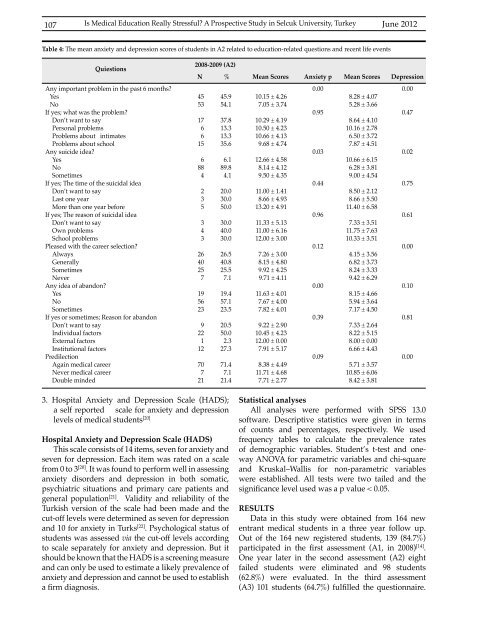Vol 44 # 2 June 2012 - Kma.org.kw
Vol 44 # 2 June 2012 - Kma.org.kw
Vol 44 # 2 June 2012 - Kma.org.kw
You also want an ePaper? Increase the reach of your titles
YUMPU automatically turns print PDFs into web optimized ePapers that Google loves.
107<br />
Is Medical Education Really Stressful? A Prospective Study in Selcuk University, Turkey<br />
<strong>June</strong> <strong>2012</strong><br />
Table 4: The mean anxiety and depression scores of students in A2 related to education-related questions and recent life events<br />
Quiestions<br />
Any important problem in the past 6 months?<br />
Yes<br />
No<br />
If yes; what was the problem?<br />
Don’t want to say<br />
Personal problems<br />
Problems about intimates<br />
Problems about school<br />
Any suicide idea?<br />
Yes<br />
No<br />
Sometimes<br />
If yes; The time of the suicidal idea<br />
Don’t want to say<br />
Last one year<br />
More than one year before<br />
If yes; The reason of suicidal idea<br />
Don’t want to say<br />
Own problems<br />
School problems<br />
Pleased with the career selection?<br />
Always<br />
Generally<br />
Sometimes<br />
Never<br />
Any idea of abandon?<br />
Yes<br />
No<br />
Sometimes<br />
If yes or sometimes; Reason for abandon<br />
Don’t want to say<br />
Individual factors<br />
External factors<br />
Institutional factors<br />
Predilection<br />
Again medical career<br />
Never medical career<br />
Double minded<br />
2008-2009 (A2)<br />
N % Mean Scores Anxiety p Mean Scores Depression<br />
0.00<br />
0.00<br />
45 45.9 10.15 ± 4.26<br />
8.28 ± 4.07<br />
53 54.1 7.05 ± 3.74<br />
5.28 ± 3.66<br />
17<br />
6<br />
6<br />
15<br />
6<br />
88<br />
4<br />
2<br />
3<br />
5<br />
3<br />
4<br />
3<br />
26<br />
40<br />
25<br />
7<br />
19<br />
56<br />
23<br />
9<br />
22<br />
1<br />
12<br />
70<br />
7<br />
21<br />
37.8<br />
13.3<br />
13.3<br />
35.6<br />
6.1<br />
89.8<br />
4.1<br />
20.0<br />
30.0<br />
50.0<br />
30.0<br />
40.0<br />
30.0<br />
26.5<br />
40.8<br />
25.5<br />
7.1<br />
19.4<br />
57.1<br />
23.5<br />
20.5<br />
50.0<br />
2.3<br />
27.3<br />
71.4<br />
7.1<br />
21.4<br />
10.29 ± 4.19<br />
10.50 ± 4.23<br />
10.66 ± 4.13<br />
9.68 ± 4.74<br />
12.66 ± 4.58<br />
8.14 ± 4.12<br />
9.50 ± 4.35<br />
11.00 ± 1.41<br />
8.66 ± 4.93<br />
13.20 ± 4.91<br />
11.33 ± 5.13<br />
11.00 ± 6.16<br />
12.00 ± 3.00<br />
7.26 ± 3.00<br />
8.15 ± 4.80<br />
9.92 ± 4.25<br />
9.71 ± 4.11<br />
11.63 ± 4.01<br />
7.67 ± 4.00<br />
7.82 ± 4.01<br />
9.22 ± 2.90<br />
10.45 ± 4.23<br />
12.00 ± 0.00<br />
7.91 ± 5.17<br />
8.38 ± 4.49<br />
11.71 ± 4.68<br />
7.71 ± 2.77<br />
0.95<br />
0.03<br />
0.<strong>44</strong><br />
0.96<br />
0.12<br />
0.00<br />
0.39<br />
0.09<br />
8.64 ± 4.10<br />
10.16 ± 2.78<br />
6.50 ± 3.72<br />
7.87 ± 4.51<br />
10.66 ± 6.15<br />
6.28 ± 3.81<br />
9.00 ± 4.54<br />
8.50 ± 2.12<br />
8.66 ± 5.50<br />
11.40 ± 6.58<br />
7.33 ± 3.51<br />
11.75 ± 7.63<br />
10.33 ± 3.51<br />
4.15 ± 3.56<br />
6.82 ± 3.73<br />
8.24 ± 3.33<br />
9.42 ± 6.29<br />
8.15 ± 4.66<br />
5.94 ± 3.64<br />
7.17 ± 4.50<br />
7.33 ± 2.64<br />
8.22 ± 5.15<br />
8.00 ± 0.00<br />
6.66 ± 4.43<br />
5.71 ± 3.57<br />
10.85 ± 6.06<br />
8.42 ± 3.81<br />
0.47<br />
0.02<br />
0.75<br />
0.61<br />
0.00<br />
0.10<br />
0.81<br />
0.00<br />
3. Hospital Anxiety and Depression Scale (HADS);<br />
a self reported scale for anxiety and depression<br />
levels of medical students [20]<br />
Hospital Anxiety and Depression Scale (HADS)<br />
This scale consists of 14 items, seven for anxiety and<br />
seven for depression. Each item was rated on a scale<br />
from 0 to 3 [20] . It was found to perform well in assessing<br />
anxiety disorders and depression in both somatic,<br />
psychiatric situations and primary care patients and<br />
general population [21] . Validity and reliability of the<br />
Turkish version of the scale had been made and the<br />
cut-off levels were determined as seven for depression<br />
and 10 for anxiety in Turks [22] . Psychological status of<br />
students was assessed via the cut-off levels according<br />
to scale separately for anxiety and depression. But it<br />
should be known that the HADS is a screening measure<br />
and can only be used to estimate a likely prevalence of<br />
anxiety and depression and cannot be used to establish<br />
a firm diagnosis.<br />
Statistical analyses<br />
All analyses were performed with SPSS 13.0<br />
software. Descriptive statistics were given in terms<br />
of counts and percentages, respectively. We used<br />
frequency tables to calculate the prevalence rates<br />
of demographic variables. Student’s t-test and oneway<br />
ANOVA for parametric variables and chi-square<br />
and Kruskal–Wallis for non-parametric variables<br />
were established. All tests were two tailed and the<br />
significance level used was a p value < 0.05.<br />
RESULTS<br />
Data in this study were obtained from 164 new<br />
entrant medical students in a three year follow up.<br />
Out of the 164 new registered students, 139 (84.7%)<br />
participated in the first assessment (A1, in 2008) [14] .<br />
One year later in the second assessment (A2) eight<br />
failed students were eliminated and 98 students<br />
(62.8%) were evaluated. In the third assessment<br />
(A3) 101 students (64.7%) fulfilled the questionnaire.
















